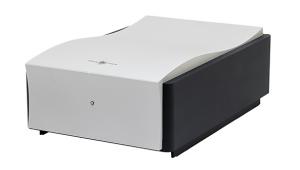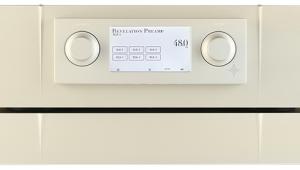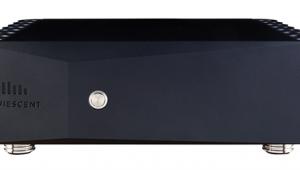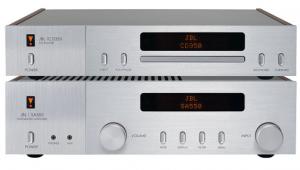Tact Audio Rcs 2.2 Xp (£2700)
Reacquaintance can be a fraught affair, as anyone who has met an old lover after many years will attest. You risk either discovering that you are still in love with them, which is usually bad news, or wondering whatever attracted you in the first place. Neither outcome is good for the ego.
It’s much the same when revisiting an audio product. You might find that you now detest something to which you once gave a rave review, or admire something you slated. But there is always the possibility of a happy outcome, when you find that equipment you previously praised still presses the right buttons. So it proved here.
In many respects little has changed in the TacT RCS 2.2 X room correction preamplifier since we were so complimentary about the previous model back in the August 2004 issue. The 2.2 XP’s box is the same solid, distinctive design as before (it even still says RCS 2.2 X on it, without the P suffix) and internally much remains the same too in that the optional analogue input/output modules and the digital input board appear unchanged.
Certainly they use the same ADC, DAC, op-amp, digital receiver and sample rate converter chips as before. I didn’t make a note of the DSP chips in the previous model but they were probably the same too as Texas Instruments has now ceased manufacturing the two TMS320s employed here.
Also unchanged is the unprepossessing plastic remote control which could do with inheriting some of the style and substance of the 2.2 XP itself.
CORRECTION ON THE FLY
What has changed are two functional aspects. First, the 2.2 XP now includes what TacT calls Dynamic Room Correction. This sees the correction filter now varied according to the setting of the volume control in order to account for the ear’s differing sensitivity versus frequency characteristic at different listening levels. This sounds to me like a hi-tech loudness control – not an immediately attractive prospect but a feature I wasn’t conscious of when using the RCS 2.2 XP. Second – and of more practical significance – it is now possible to initiate and control the room measurement and correction process without having to connect up a PC, as was the case previously.
If you are computer literate this may not seem such a breakthrough but the plain fact is that many users dislike having to use a computer to setup audio equipment. TacT still supplies its PC software and the leads for connecting a computer to the RCS via an RS232 serial interface, and the software provides greater flexibility in terms of choosing and refining target functions. But good results can be achieved without it.
Making room measurements via the RCS is simple (although the document describing the process wasn’t supplied with the review sample – I had to download it from TacT’s website). First you place the supplied microphone at head height at the listening position and initiate the impulse measurement procedure from the appropriate front panel menu screen using the remote control. When the measurement is complete, the RCS computes the target function and correction automatically. Nine presets are available for storing corrections for different listening positions or, if you use the PC link, the presets can be assigned corrections for different target functions.
REAL TIME EQ
If you opt for the auto target function approach you are not saddled with what the RCS dictates. Using the Edit menu you can apply equalisation in octave bands to tweak the tonal balance – a facility I made good use of in my listening. This EQ is not global but specific to each preset, and operates in real time so you can hear the effect as you adjust the response on-screen.
Because most users will opt for the no-PC setup procedure, this is what I used for my listening. Other system components comprised a Krell SACD Standard player (connected via S/PDIF), Krell FBI integrated amplifier and a pair of B&W 805S speakers, with mains power provided by a PS Audio Power Plant Premier [see p60].
My immediate reaction to the equalised sound – which can be quickly compared to the unprocessed version via the remote’s Bypass button – was mostly very positive. An upper bass/lower midrange thickening was removed, deep bass gained in control and extension, and stereo image precision was markedly improved. But the sound was too upper mid-forward, as with speakers having a deliberate presence region boost, which made me call up the response Edit function and apply some attenuation at 1, 2 and 4kHz.
A KIND OF MAGIC
The reason for this forwardness became apparent when I measured the corrected in-room response and discovered a broad peak between 1 and 2kHz. Whether this is a consistent feature I don’t know because I’ve only tried the 2.2 XP in one room, but it looks suspiciously like a ploy to make the effect of the 2.2 XP’s correction immediately noticeable in dealer demos. If so then it’s quite unnecessary: the benefits are obvious without it.
I’m going to break with style at this juncture and not quote particular instances because the key to the 2.2 XP’s success is that it brings its benefits to music of all types. On classical, jazz and rock recordings, made in all decades from the 1950s to the present, it worked a consistent magic, adding weight and tunefulness to the bass, clarifying the midrange and conferring enhanced precision and stability on the stereo image.
VERDICT
TacT’s was the original successful wide-bandwidth DSP room correction product and, of those I’ve tried, it remains the best. Its choice of digital and analogue inputs and outputs ensures that it is extremely flexible, its new no-PC measurement option makes it a breeze to setup and, with a little tonal tweaking, it performs excellently, transforming sound quality on all types of music.
Originally published in the February 2008 issue
























































